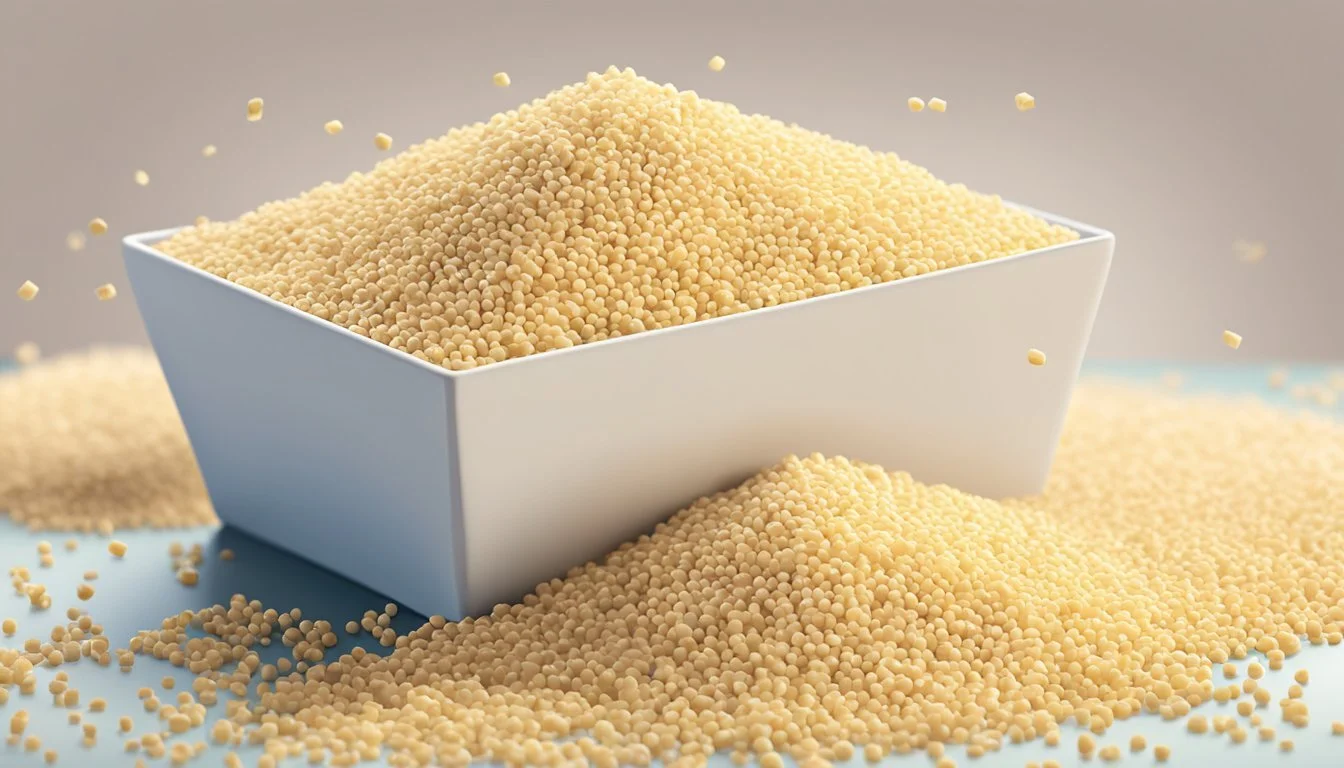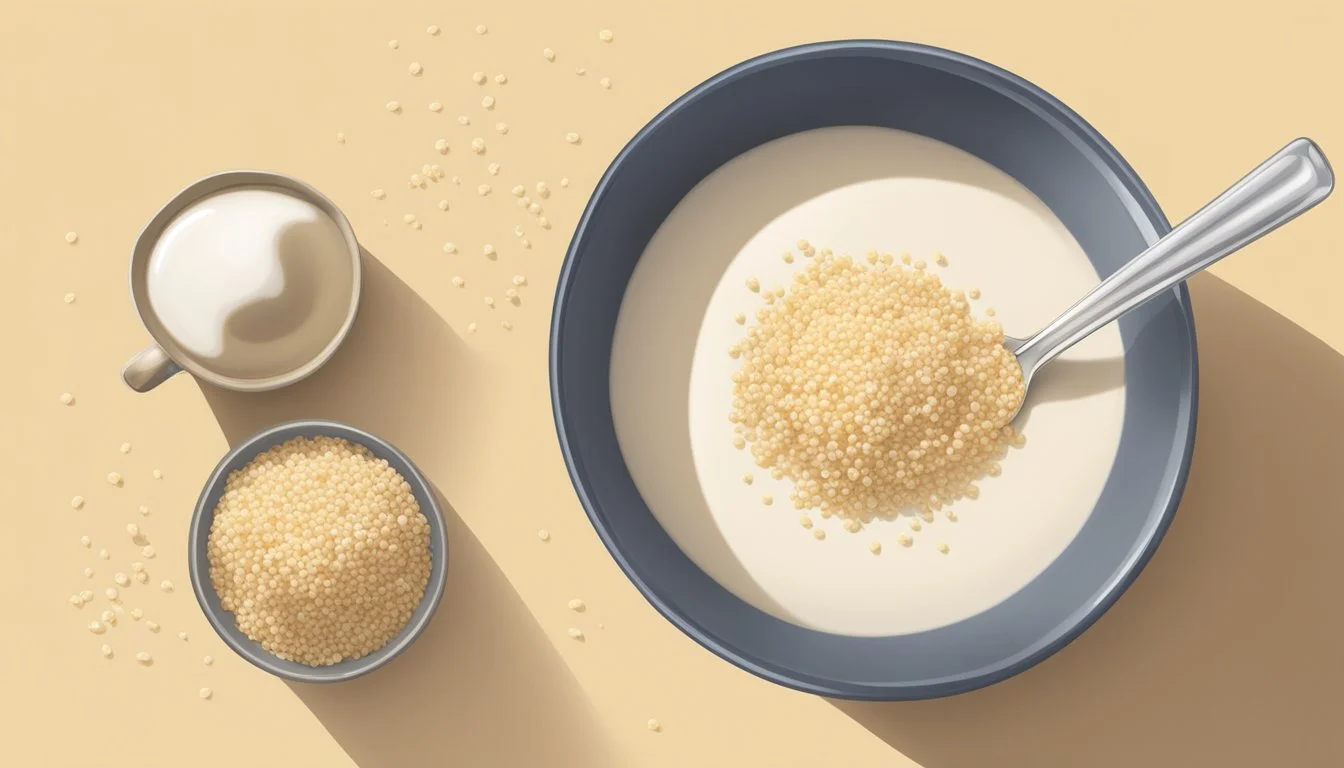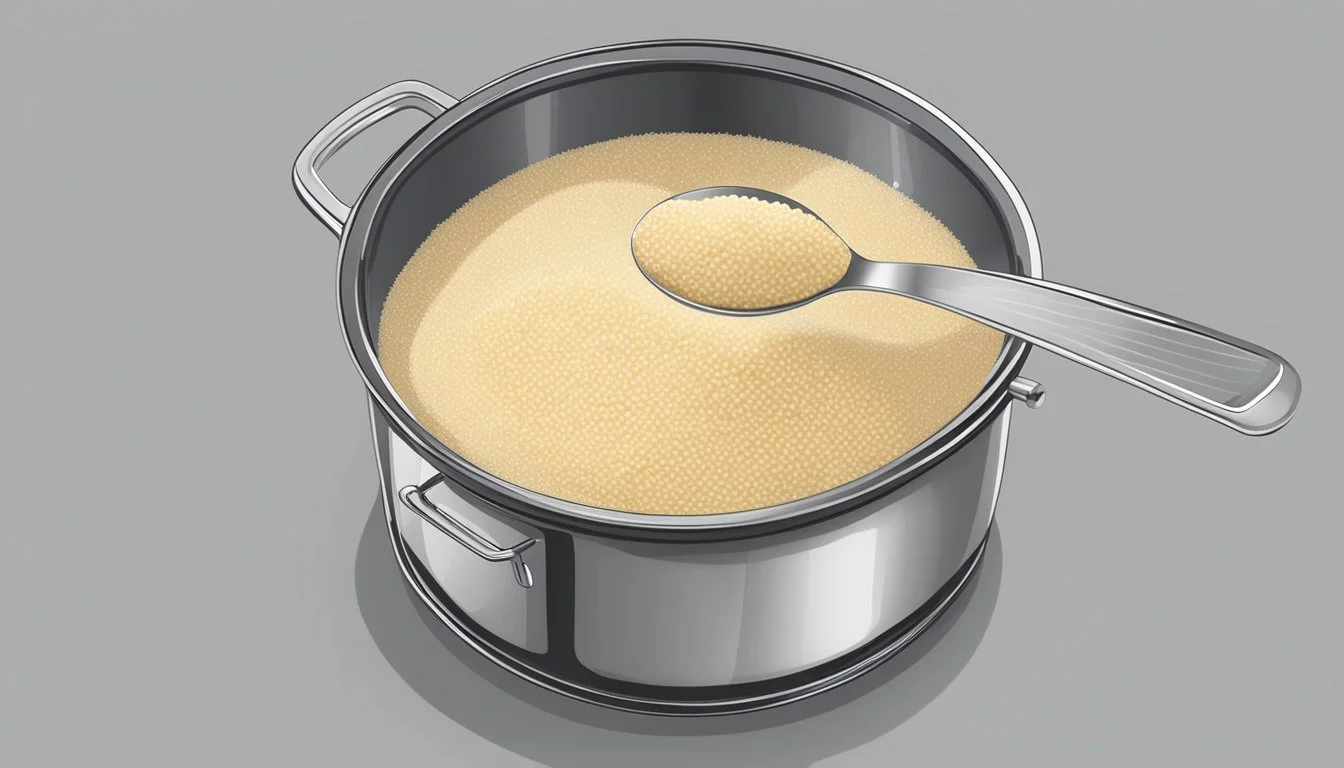How Many Servings of Quinoa Milk Is Too Much
A Dietary Guide
Quinoa milk, a nutritious plant-based alternative to dairy, packs numerous health benefits, including essential amino acids, fiber, and vitamins. Yet, consuming more than 1 to 2 servings of quinoa milk a day could lead to excessive intake of certain nutrients, such as manganese and fiber, which may cause digestive discomfort. It's crucial to balance quinoa milk with other dietary sources to maintain overall nutritional harmony.
In moderation, quinoa milk can be an excellent addition to your daily diet, offering a protein-rich option for those with lactose intolerance or those seeking a vegan-friendly milk alternative. Each serving, typically one cup, should be enough to reap the benefits without overwhelming your diet.
By understanding the ideal portion sizes and benefits of quinoa milk, readers can better incorporate this versatile drink into their diet without worry of overconsumption. Moderation and variety are key to a well-rounded and healthy diet.
Understanding Quinoa
Quinoa is a unique seed that functions like a whole grain. It stands out because of its impressive nutritional profile which includes protein, fiber, and several essential amino acids.
A single cup of cooked quinoa contains approximately:
222 calories
8 grams of protein
5 grams of fiber
39 grams of carbohydrates
4 grams of fat
Quinoa is a complete protein, making it a fantastic option for those on a plant-based diet. This means it provides all nine essential amino acids that the body cannot produce on its own.
In addition to protein, quinoa is rich in essential minerals:
Mineral % of Recommended Daily Allowance (RDA) per cup Magnesium 30% Manganese 58% Iron Significant amounts Zinc Notable amounts
Quinoa is also a good source of various vitamins and minerals, contributing to its nutritional benefits. It's particularly high in magnesium, which plays a crucial role in muscle and nerve function.
For those with dietary restrictions, quinoa is gluten-free, making it a safe grain alternative for individuals with gluten sensitivities or celiac disease. This seed is versatile and can be easily incorporated into various diets, providing a multitude of essential nutrients without gluten.
By including quinoa in their diet, individuals can benefit from its complete protein and high fiber content, alongside an array of vitamins and minerals, promoting overall health and nutrition.
Nutritional Profile of Quinoa Milk
Quinoa milk is a nutrient-dense, plant-based milk alternative. It offers a variety of essential nutrients that contribute to a balanced diet.
A single serving of quinoa milk typically contains around 50-70 calories. This makes it a low-calorie option compared to some other non-dairy milks.
In terms of macronutrients, quinoa milk contains fat, carbohydrates, and protein.
Fat: About 2-3 grams per serving, including healthy unsaturated fats.
Carbohydrates: Approximately 8-12 grams, providing a good source of energy.
Sugar: Low in sugar, usually around 2-3 grams.
Each serving usually includes 2-4 grams of protein, which is higher than in many other plant-based milks.
Quinoa milk is also rich in vitamins and minerals. These include:
Vitamins: Vitamin E, B vitamins.
Minerals: Magnesium, iron, potassium, and calcium.
It contains essential amino acids, making it a complete protein source. This is particularly beneficial for those on plant-based diets.
Omega-3 fatty acids are present in moderate amounts, contributing to heart and brain health.
Antioxidants found in quinoa milk help fight oxidative stress, supporting overall wellness.
This nutritional content makes quinoa milk a valuable addition to a multi-faceted diet.
Health Benefits of Quinoa Milk
Quinoa milk offers a range of health benefits, including support for managing weight and improving heart and digestive health. It also helps in managing diabetes and reducing inflammation.
Weight Management
Quinoa milk can be beneficial for weight management thanks to its nutrient profile. It contains plant-based protein and essential amino acids, which can help increase satiety and reduce overall calorie intake. Each cup of quinoa milk is relatively low in calories compared to many dairy alternatives, making it a good option for those looking to maintain or achieve a healthy weight. Additionally, the fiber content in quinoa milk can promote fullness, helping to prevent overeating.
Heart Health
Consuming quinoa milk may contribute to better heart health. Quinoa contains nutrients that are known to improve heart function, such as omega-3 fatty acids and antioxidants. The regular intake of quinoa milk can help lower cholesterol levels and blood pressure, reducing the risk of heart disease. Its low glycemic index also means it has minimal impact on blood sugar levels, supporting heart health.
Digestive Health
Quinoa milk is rich in fiber, which aids in digestion and helps prevent constipation. Being a gluten-free option, it is suitable for individuals with celiac disease or gluten sensitivity. Consuming fiber-rich foods like quinoa milk can support bowel regularity and a healthy digestive system. Moreover, its nutrient density can promote overall gut health.
Diabetes Management
For those managing type 2 diabetes, quinoa milk might be a beneficial addition to their diet. Its low glycemic index means it has a minimal impact on blood sugar levels. Additionally, the presence of complex carbs and fiber can help regulate glucose levels, stabilizing energy and preventing spikes in blood sugar. These properties make quinoa milk a good choice for maintaining stable blood sugar levels.
Anti-inflammatory Effects
Quinoa milk boasts anti-inflammatory properties, thanks to compounds like quercetin and other antioxidants. These components can help reduce chronic inflammation, which is linked to various health issues such as heart disease and diabetes. Regular consumption of foods that fight inflammation, like quinoa milk, can support overall health and potentially lower the risk of chronic diseases.
Preparing and Cooking Quinoa
Quinoa is a versatile and nutritious grain that's easy to prepare. This section outlines basic cooking techniques, creative ways to use quinoa in meals, and compares it to other grains.
Basic Quinoa Cooking Techniques
To cook quinoa, start by rinsing the grains under cold water to remove the natural coating called saponins, which can be bitter. Use a fine mesh strainer for this step.
Combine 1 cup of quinoa with 2 cups of water in a pot. Bring it to a boil over high heat. Once boiling, reduce the heat to medium-low, cover with a lid, and let it simmer for about 15 minutes.
Check if the water is absorbed and the quinoa is tender by fluffing with a fork. If it's done, remove from heat and let it stand for 5-10 minutes with the lid on. This ensures a fluffy texture.
Creative Applications in Meals
Quinoa is incredibly versatile. It can be used as a base for salads, replacing refined grains like rice in a salad. Toss it with chopped vegetables, a light dressing, and perhaps some nuts for added crunch.
It also makes a great side dish. Mix cooked quinoa with herbs and a splash of lemon juice for a simple yet flavorful accompaniment to any main course.
For breakfast, treat quinoa like a cereal. Cook it with milk and a bit of sweetener, then top with fresh fruit or nuts. Its high fiber content makes it a nutritious start to the day.
Comparing Quinoa to Other Grains
Quinoa stands out among other grains due to its nutritional profile. Unlike refined grains, it is a whole grain, meaning it retains its fiber and nutrients.
Compared to white rice, quinoa has more protein and essential amino acids. It's also gluten-free, making it accessible for those with gluten intolerance.
Other grains like barley and farro offer similar benefits, but quinoa’s quick cooking time and versatile texture make it a preferred choice for many recipes.
Safety and Dietary Considerations
Quinoa milk is a nutritious, plant-based alternative to dairy and is popular among vegans and those with lactose intolerance. However, consumers need to be mindful of potential allergies and the appropriate serving size to avoid any adverse effects.
Allergies and Intolerances
Some individuals may experience allergies or intolerances to quinoa or quinoa-based products. Common symptoms include:
Skin rashes
Digestive issues such as bloating and stomach pain
Respiratory problems such as wheezing or difficulty breathing
These symptoms usually appear shortly after consumption. People with celiac disease or gluten intolerance generally find quinoa to be a safe alternative as it is naturally gluten-free. However, it's essential to check for cross-contamination if processed in facilities that handle gluten-containing grains.
Optimal Serving Sizes
The appropriate serving size of quinoa milk depends on individual nutritional needs and lifestyle. A typical serving of quinoa milk (240 ml or 1 cup) contains essential nutrients such as:
Calories: Approximately 70-100
Protein: 2-3 grams
Carbohydrates: 12-15 grams
Fat: 2-4 grams
Consuming 1-2 servings per day is generally sufficient for most individuals, providing benefits without overconsumption. Overindulgence can lead to excessive calorie intake, affecting weight management. Balancing quinoa milk with other nutrient-dense foods ensures a well-rounded diet.
Moderation is key to reaping the health benefits of quinoa milk while maintaining a balanced diet.
Quinoa Milk Versus Other Plant-Based Milks
Quinoa milk is a popular choice for those seeking a plant-based milk option with a unique nutritional profile. Made from quinoa, a gluten-free grain, it provides a good source of protein and essential amino acids. This sets it apart from some other plant-based milks which may lack such nutrients.
Nutritional Comparison
Almond Milk: Known for its mild flavor and low calorie count, almond milk often contains added vitamins but may have less protein than quinoa milk.
Soy Milk: High in protein and often fortified with vitamins and minerals, soy milk's nutritional profile is quite robust. It's a common substitute for dairy milk due to its similar protein content.
Oat Milk: Favored for its creamy texture, oat milk provides fiber and B vitamins. However, it has a higher carbohydrate content compared to quinoa milk.
Dietary Preferences
Vegans and Vegetarians: Quinoa milk is suitable for vegan and vegetarian diets. It’s also free from dairy, soy, and nuts, making it an excellent alternative for those with allergies.
Lactose Intolerance: Like other plant-based milks, quinoa milk is free from lactose, providing an option for those who are lactose intolerant.
Taste and Usage
Quinoa milk has an earthy, slightly sweet taste that works well in various recipes. Its texture is relatively thin, which may affect its versatility compared to creamier options like oat milk. Yet, it remains a valuable choice for baking and cooking where a lighter consistency is preferred.
Summary Table
Milk Type Protein Calories Key Nutrients Quinoa Milk Moderate Moderate Essential Amino Acids Almond Milk Low Low Vitamin E, Calcium Soy Milk High Moderate Protein, Calcium, Vitamin D Oat Milk Moderate High Fiber, B Vitamins
Each plant-based milk offers distinct benefits, and quinoa milk is notable for its balanced nutritional profile and suitability for various dietary needs.
Environmental Impact of Quinoa Cultivation
Quinoa cultivation has garnered attention due to its environmental footprint. The primary concern is the carbon dioxide (CO₂) emissions associated with its production. For instance, it has been noted that producing 1 kg of quinoa can result in approximately 1.48 kg of CO₂ emissions. This is primarily due to the use of machinery and other man-made resources.
Water usage is another critical factor in the environmental impact of quinoa cultivation. Quinoa can grow in arid conditions, which reduces the need for excessive irrigation. This makes it a plant-based crop with a relatively lower water footprint compared to other grains.
Sustainable farming practices are essential for minimizing the environmental impact of quinoa. These practices include crop rotation, reduced chemical usage, and efficient resource management. Implementing such methods can help improve soil health and reduce harmful emissions.
Key Points:
CO₂ Emissions: 1 kg of quinoa = ~1.48 kg CO₂
Water Usage: Quinoa requires less water due to its adaptability to arid conditions.
Sustainable Farming: Crop rotation and reduced chemical usage improve environmental outcomes.
Adopting quinoa as a part of a sustainable, plant-based diet can contribute to lower environmental impacts. Implementing and promoting eco-friendly farming techniques can significantly reduce the negative effects associated with its cultivation.
Selection and Storage of Quinoa and Quinoa Milk
When selecting quinoa, consider the three common varieties: white, red, and black quinoa. White quinoa has a mild flavor and light texture, making it versatile for many dishes. Red quinoa has a nuttier taste and chewier texture, ideal for salads. Black quinoa offers an earthier flavor and crunchier texture.
It's important to purchase quinoa from a reputable source to ensure quality. Quinoa should be stored in an airtight container in a cool, dark place to maintain freshness. This helps preserve its nutritional value and extend its shelf life.
Quinoa Unopened (pantry) Opened (pantry) Dry Up to 2 years 6-12 months Cooked Not applicable Up to 7 days (fridge)
Quinoa is naturally coated with saponin, a bitter compound that needs to be rinsed off before cooking. This improves taste and digestibility.
For quinoa milk, store it in the refrigerator in a sealed container. Quinoa milk can typically last 3-5 days in the refrigerator. Shake well before using, as homemade quinoa milk tends to separate.
Proper selection and storage of quinoa and quinoa milk ensure they remain fresh and nutritious, supporting a healthy diet.







